
The deep-fried lotus root slices, it’s like a passionate dance between the lotus root and the oil. As the lotus root slices are fried in hot oil, they leap and twirl in the pan, showcasing their enthusiasm and vitality. With time, their appearance gradually turns golden and crispy, releasing an enticing aroma. Each slice of lotus root is like a meticulously carved piece of art, some with graceful shapes, others twisted like spirals, or spreading like branches, allowing us to appreciate the beauty of food while indulging in its flavors.
Ingredients for The deep-fried lotus root slices:
| Lotus root | 500g |
| Ginger | 5g |
| Garlic | 5g |
| Sichuan Pepper | 5g |
| Scallion | 6g |
| Coriander | 6g |
| Salt | 2g |
| Aginomoto | 1g |
| Sugar | 1g |
| Pepper powder | 1g |
| Cornstarch | 10g |
Step:
1.First, let’s prepare the ingredients. Take a section of lotus root, peel off the outer skin, and place it in a bowl. Pour in some clean water and thoroughly rinse the lotus root to ensure its surface is free from dirt. Next, cut the lotus root into sections and then slice it. Make sure each slice has roughly the same thickness so they can be evenly heated during frying. Then, cut the sliced lotus root into uniform strips, choosing an appropriate width according to personal preference. Place the cut lotus root strips in a bowl for later use. With these steps, we have successfully prepared the lotus root, cutting it into even strips in preparation for frying.
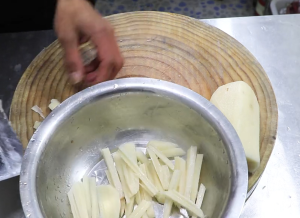
2.Next, flatten a piece of ginger on a cutting board by using forceful taps to make it easier to cut. Then, chop the flattened ginger into minced pieces, ensuring they are of uniform size. Similarly, take three large garlic cloves and flatten them as well to facilitate cutting. Proceed to finely chop the flattened garlic cloves into minced pieces. Place the minced ginger and garlic in the same bowl for later use. This will allow for convenient use and even seasoning distribution during the cooking process. With these steps, we have prepared minced ginger and garlic.
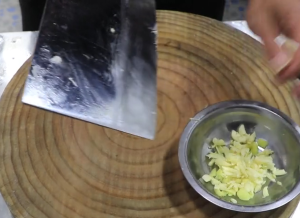
3.Now, let’s prepare another small bowl. Add a handful of Sichuan peppercorns and dried chili peppers to the bowl. These will be used as seasonings when frying the dry pot dish. Sichuan peppercorns and dried chili peppers are essential flavorings that bring unique spiciness to the dish. Set them aside in the small bowl to ensure easy access during frying.
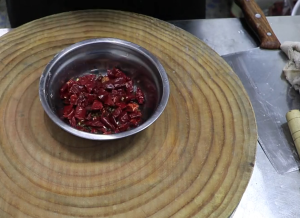
4.Moving on, let’s prepare scallions, cilantro, and white sesame seeds. Cut three scallions into sections and place them in the small bowl for later use. Take a suitable amount of fresh cilantro and cut it into small sections, then mix it with the chopped scallions. Additionally, grab a handful of white sesame seeds and add them to the small bowl. White sesame seeds add aroma and texture to the dry pot dish. By combining the chopped cilantro, scallions, and white sesame seeds, they will complement each other in flavor and enhance the overall texture and taste of the dry pot dish. With these steps, we have successfully prepared the chopped scallions, cilantro, and white sesame seeds.
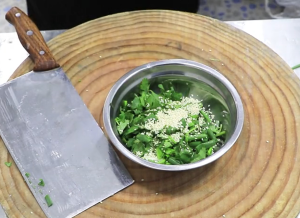
5.Next, let’s further process the lotus root. Crack an egg into the bowl of sliced lotus root and use chopsticks to mix it well, ensuring that the egg coats the lotus root thoroughly. Gradually add an appropriate amount of cornstarch while continuing to stir until well combined. It’s best to add the cornstarch in small increments to ensure each piece of lotus root is evenly coated without sticking together. Be sure to mix the egg and cornstarch thoroughly with the lotus root so that they form a crispy outer layer when fried. With these steps, we have successfully mixed the egg and cornstarch with the lotus root, ensuring each piece is evenly coated.
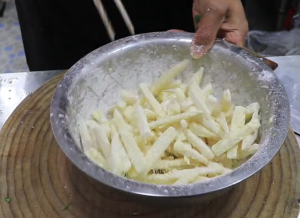
6.Now, let’s fry the lotus root. Heat a pan and pour in a sufficient amount of oil. When the oil reaches around 50% heat, there will be slight smoke. Gradually add the prepared and coated lotus root slices into the pan one by one. As the lotus root comes into contact with the heat, it will quickly become firm. Gently shake the pan and continuously stir with a spoon to prevent the lotus root from sticking to the bottom. If some pieces stick together, use the spoon to separate them. Adjust the heat to low and continue frying for about 3 minutes, until the surface of the lotus root turns golden yellow. This ensures that the lotus root is cooked through and has a crispy exterior. Once fried, use a slotted spoon or spatula to remove the lotus root from the pan, draining off any excess oil. With these steps, we have successfully fried the lotus root, achieving a golden and crispy texture.
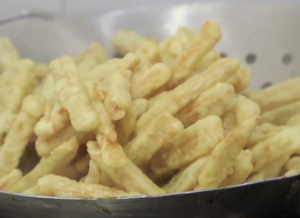
7.Continuing, let’s keep the base oil in the pan and heat it up again. Once the oil is sufficiently hot, add the previously prepared Sichuan peppercorns and dried chili peppers. Pay attention to controlling the temperature to avoid burning the chili peppers. Stir-fry the Sichuan peppercorns and dried chili peppers to release their fragrant spiciness. Then, add the prepared minced ginger and garlic, continuing to stir-fry until the garlic becomes aromatic. Next, pour the fried lotus root into the pan. Adjust the heat to low and stir-fry for about 1 minute, allowing the lotus root to absorb the flavors of the chili peppers. Sprinkle in 2 grams of salt, a pinch of Aginomoto, 1 gram of pepper, and an appropriate amount of sugar. Continue stir-frying to evenly coat the lotus root with the seasonings. Finally, add the prepared scallions, cilantro, and white sesame seeds. Toss the pan to evenly distribute all the ingredients over the lotus root. With these steps, we have successfully mixed the seasonings with the fried lotus root, allowing it to absorb the spicy and aromatic flavors.
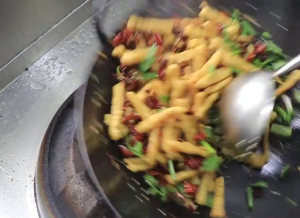
8.Once the lotus root is thoroughly stir-fried with the seasonings, it can be removed from the pan and plated. Gently transfer the dry pot lotus root onto a serving dish, trying to maintain their shape as much as possible. You can use a spatula or chopsticks to help arrange them for a more visually appealing presentation.
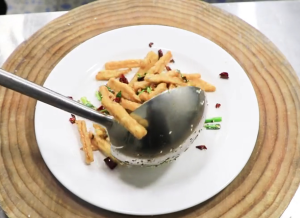
Tips:
1.Cut the lotus root into strips, trying to maintain a uniform thickness. This will ensure that the lotus root strips are evenly heated during frying, resulting in a better texture.
2.Ensure that the oil temperature is moderate, around 160-180 degrees Celsius. If the temperature is too low, the lotus root strips will absorb too much oil. If the temperature is too high, they may burn on the outside while remaining undercooked on the inside. It’s a good idea to use a thermometer to check the oil temperature.
Dry-fried lotus root strips resemble crispy young dancers, gracefully moving with allure. Their golden and crispy exterior is like a delicate dance costume, while the tender lotus root flesh inside is as pure and smooth as hidden delicate skin. Each strip of lotus root seems to be a dancing melody, with its enticing aroma lingering in the air, tempting you to take a bite. And when you bite into the lotus root, it bursts open, revealing a delicious taste that is truly captivating. Dry-fried lotus root strips are a dish that can greatly stimulate your appetite and leave you longing for more. It is a delightful homemade delicacy that leaves a lasting impression.

